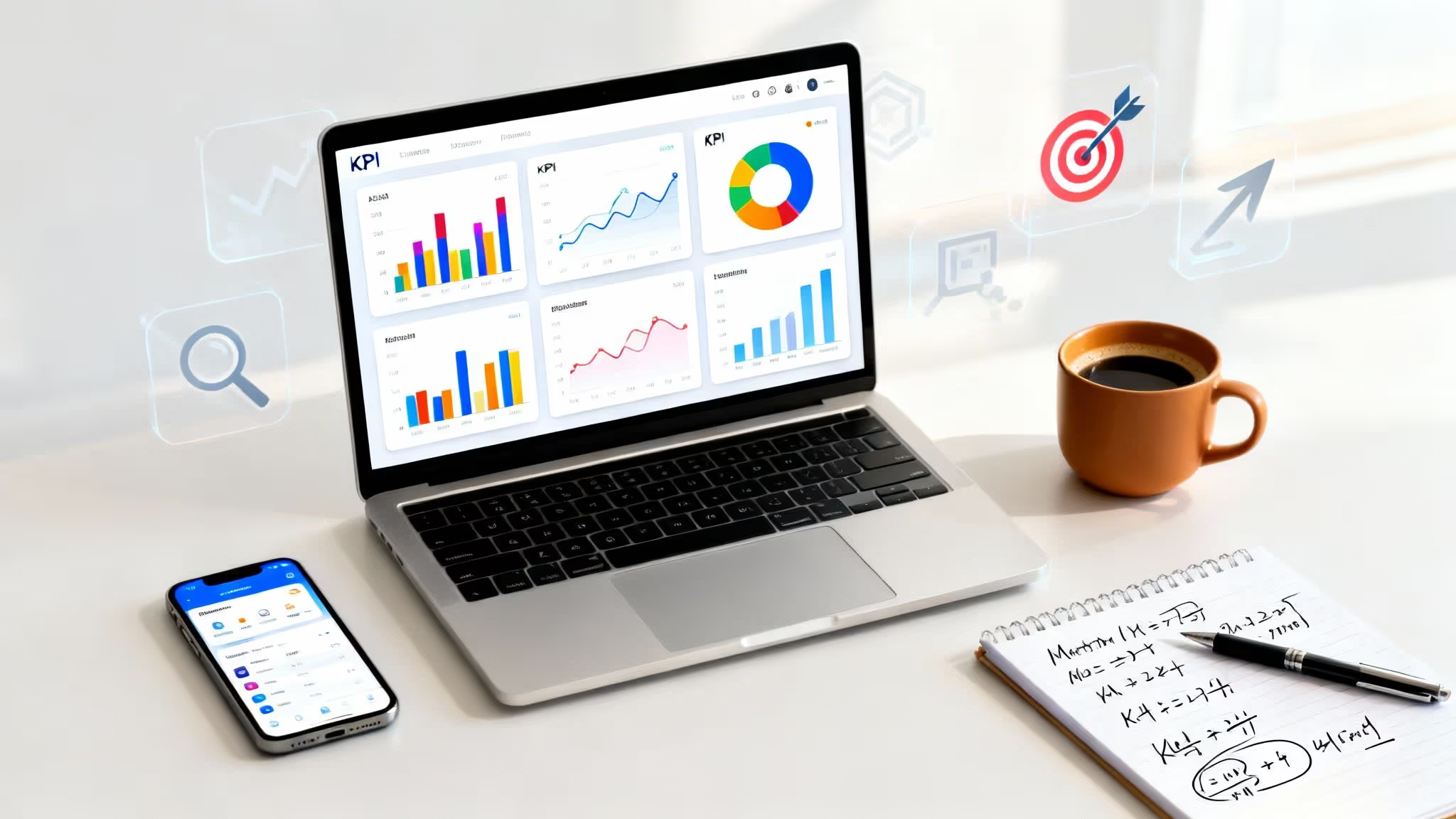Pay-per-click (PPC) advertising for ecommerce is a direct, powerful method for placing your products in front of consumers who are actively looking to buy right now. This isn't about waiting for customers to find you; it's about meeting them at the precise moment of their search.
While organic SEO is a crucial long-term strategy—akin to building a flagship store—PPC delivers immediate visibility. It's the grand opening that can drive a surge of traffic and sales from day one, providing invaluable data along the way.
Why PPC Is a Fundamental Growth Engine for Ecommerce
For any ecommerce business, PPC isn't just another marketing channel; it's a primary engine for growth. It allows you to command prime real estate at the top of Google's search results, ensuring your products are seen first. This direct line to shoppers with high purchase intent is what makes it so remarkably effective.
The Immediate Impact on Growth
The single greatest advantage of a well-executed PPC campaign is speed. You can launch a campaign in the morning and see traffic, and potentially sales, by the afternoon. This rapid feedback loop allows you to test and refine your products, pricing, and messaging in near real-time.
Here’s what that immediate impact looks like in practice:
- Targeted Customer Reach: You connect with individuals who have just expressed their intent to buy what you sell through their search queries.
- Measurable ROI: Every dollar spent is trackable. This enables you to precisely measure your Return on Ad Spend (ROAS) and scale the campaigns that are generating profit.
- Enhanced Brand Visibility: Consistently appearing at the top of search results builds brand familiarity and trust, even within a paid placement.
This chart illustrates the growth trajectory possible with a dedicated PPC strategy, tracking revenue, conversion rates, and overall return on investment.
As you can see, a consistent and optimized investment doesn't just increase sales; it can lead to significant revenue growth while maintaining healthy conversion rates and returns.
Strategic Value Beyond Clicks
It's easy to reduce PPC to "buying clicks." However, this overlooks its deeper strategic value. What you are truly acquiring is data—invaluable market intelligence that can inform your entire business strategy. Insights from PPC can reveal which products are in demand, the exact language customers use, and which advertising messages resonate most effectively.
PPC visitors have a 50% higher likelihood of making a purchase compared to organic visitors. This statistic alone highlights the power of commercial intent behind paid clicks.
This is precisely why PPC is important for your organization. The data is clear: for high-intent commercial keywords, sponsored results capture 65% of the clicks, leaving just 35% for organic results. When a consumer is ready to buy, they often click the most relevant and visible result—which is typically a paid ad.
To give you a clearer picture of how these two powerful channels differ, let's break them down side-by-side.
PPC vs. Organic Search: Key Differences for Ecommerce
Ultimately, a winning ecommerce strategy integrates both PPC and SEO. It uses paid ads for immediate impact and data gathering while building a strong organic foundation for lasting success.
Building Your Ecommerce PPC Blueprint
An effective PPC campaign begins with a solid plan—a blueprint. This foundational stage moves you from a general understanding of PPC to a precise strategy for driving growth. Before allocating any budget, you need a clear plan of attack to ensure every action is deliberate, measurable, and tied to your business goals.
Define Your Core Business Objectives
First, what does "success" look like for your store? Simply aiming for "more sales" is too vague. Effective PPC goals are specific, as they guide every subsequent decision, from keyword selection to bidding strategy.
Consider what you are truly aiming to achieve:
- Maximize Sales Volume: This objective focuses on generating the highest possible revenue, often by promoting best-selling products. It’s an effective approach for capturing market share or liquidating inventory.
- Improve Profit Margins: Here, the focus shifts from revenue to profit. You allocate your budget to high-margin items and monitor your Return On Ad Spend (ROAS) meticulously.
- Establish Brand Dominance: This goal is about owning your niche by appearing consistently for core search terms. This can build long-term brand equity, sometimes at the cost of a lower immediate ROAS.
Selecting one primary objective provides clarity. A campaign designed for profit will differ significantly from one built for brand awareness. This decision shapes your budget, bidding strategy, and key performance indicators.
Create Detailed Customer Personas
Effective marketing requires a deep understanding of your audience. Customer personas—detailed, semi-fictional profiles of your ideal buyers—help you understand their motivations and behaviors.
A strong persona includes:
- Demographics: Age, location, income.
- Psychographics: Values, hobbies, interests, and pain points.
- Shopping Habits: Online behavior, purchase drivers, and preferences (e.g., bargain hunter vs. quality seeker).
For example, if you sell high-end, sustainable yoga mats, you might create a persona for "Eco-Conscious Erin," a 32-year-old urban professional who values ethical brands and is willing to pay a premium for quality. This insight informs your ad copy (e.g., "eco-friendly materials") and targeting (e.g., interests in wellness and sustainability).
A deep understanding of your customer is the bedrock of effective advertising. When you know who you’re talking to, you can craft messages that resonate on a personal level, turning a simple ad into a compelling invitation.
Uncover High-Intent Keywords
With your goals and customer personas established, the next step is to identify the search terms your ideal customers use when they are ready to buy. This is a critical step in any strategy for PPC for ecommerce. The objective is to distinguish between informational queries and purchase-intent queries.
- Informational Keywords: "how to clean a yoga mat" (User is seeking information).
- Commercial Keywords: "buy non-slip cork yoga mat" (User is ready to purchase).
Your primary focus should be on commercial keywords. These phrases indicate a user is at the final stage of the buying journey. Tools like Google Keyword Planner, Ahrefs, and Semrush are essential for discovering these terms and evaluating their search volume.
Analyze Your Competitors' Strategies
Finally, a robust blueprint includes competitive analysis. The goal is not to imitate but to identify gaps and opportunities in the market. By examining competitor campaigns, you can uncover strategic advantages.
Key questions to ask include:
- Which keywords are they bidding on?
- What unique selling propositions are they highlighting in their ads?
- Which of their products are they promoting most heavily?
This analysis might reveal that a key feature of your product is not being advertised by competitors, or that a valuable long-tail keyword is being overlooked. This is your opportunity to gain a competitive edge.
This blueprint ensures your ad spend works smarter, not just harder, building a foundation for profitable and sustainable growth. For a deeper dive into crafting a winning strategy, you might be interested in our complete guide on PPC for e-commerce.
Choosing the Right Platforms for Your Products
Deciding where to allocate your PPC for ecommerce budget is as critical as choosing a physical retail location. You must place your ads where your customers are actively looking, ensuring your ad spend is not wasted.
This decision is fundamental to your campaign's success. It's the difference between generating a tangible return and having your budget disappear without results. The key is to match the platform to your product and the customer's mindset. Are they actively searching with purchase intent, or are they scrolling through a social feed, open to discovery? Answering this question is the first step toward a functional PPC strategy.
Mastering the Google Ads Ecosystem
For nearly every ecommerce business, the path to purchase begins on Google. It is the undisputed leader in high-intent traffic. People use Google when they have a problem to solve or a specific product to buy. However, "Google Ads" is not a single entity but a comprehensive ecosystem of powerful, specialized tools.
Google Search Ads: This is the classic PPC format. When a user searches for "buy waterproof running shoes," your text ad appears. It is ideal for capturing buyers who know what they want and are actively seeking to purchase.
Google Shopping Ads: These are the product listings with images, prices, and your store name that appear at the top of search results. For businesses selling physical products, these are essential. They allow shoppers to compare options visually and often achieve higher conversion rates than text ads due to their informative nature.
Performance Max (PMax): PMax is Google's AI-driven, all-in-one campaign type. You provide the assets—ad copy, images, videos, and a product feed—and its machine learning algorithm finds customers across the entire Google network, including Search, Shopping, YouTube, and Gmail. It is an excellent way to scale your reach and leverage automation.
A solid strategy for a new store often begins with Google Shopping to secure initial, high-intent sales. This can be supplemented with Search Ads targeting specific, high-value keywords. Once sufficient conversion data is gathered, Performance Max can be layered in to broaden reach.
Capitalizing on Social Commerce
While Google excels at capturing existing demand, social media is where you can create it. On these platforms, you connect with individuals who may not be actively shopping but are receptive to discovering new products.
The paid search landscape is evolving rapidly. With global spending projected to reach $351.5 billion by 2025, the market is also fragmenting. Amazon now commands 22.3% of search ad spend, and TikTok is emerging as a significant player.
This data indicates that a multi-platform approach is becoming necessary. Rising ad costs and new privacy regulations mean that simply increasing budgets no longer guarantees success. Selecting the right mix of platforms is more critical than ever for maintaining profitability. You can explore more data on these important PPC trends and what they mean for your business.
Meta Ads for Visual and Lifestyle Brands
Meta, the parent company of Facebook and Instagram, is a titan of social commerce. Its primary strength lies in its detailed audience targeting capabilities and its visual-first environment, making it ideal for specific product categories:
- Fashion and Apparel: Instagram functions as a digital runway. Visuals are paramount, and you can target users based on their interests in specific brands, styles, or fashion influencers.
- Home Goods and Decor: Users turn to Facebook and Instagram for home inspiration. An ad featuring your product in a well-staged setting can trigger an impulse purchase.
- Hobby and Niche Products: Whether you sell specialty crafting supplies or unique fitness gear, Meta enables you to target tight-knit communities centered around those interests.
Tapping Into Product Discovery Engines
Beyond Google and Meta, other platforms offer unique opportunities for customer acquisition.
Pinterest: More than a social network, Pinterest is a visual discovery engine used for planning. Users actively search for ideas and products related to projects, life events, and hobbies. If your products are in categories like home decor, weddings, recipes, or DIY, Pinterest is an essential platform.
TikTok: While it's easy to underestimate TikTok, its algorithm is incredibly effective at product discovery. A short, authentic video demonstrating how your product solves a problem can go viral and drive a significant volume of sales, often from consumers who were not previously aware of their need.
Your ideal platform mix depends on your product line. A store selling specialized automotive parts will likely find success on Google Search and Shopping. A boutique selling handmade jewelry is better suited for Instagram and Pinterest. The most prudent approach is to start where purchase intent is highest (Google) and then strategically expand to social platforms to build your brand and create new demand.
Now, let's move from theory to practical application. The following steps will guide you through building a foundational ecommerce campaign from the ground up, using Google Shopping as our primary example. This process is fundamental to any serious PPC for ecommerce strategy.
Connecting Your Store to Google
Before you can run a Shopping ad, Google needs access to your product inventory. This connection is made through the Google Merchant Center (GMC). GMC acts as a digital warehouse for your product data, syncing with your store to pull crucial information like prices, images, and stock levels directly into Google Ads.
Connecting GMC is a mandatory first step. Once linked to your Google Ads account, it enables the creation of dynamic Shopping campaigns that automatically update as your inventory changes. This ensures your ads remain accurate, which is vital for building shopper trust and driving conversions.
Structuring Ad Groups for Maximum Control
With your product feed active, it's time to structure your campaign. A common mistake is to place all products into a single, large ad group. This approach offers no control and makes optimization nearly impossible.
A more effective strategy is to segment your ad groups by product category or brand. For instance, an athletic apparel retailer would not group "running shoes" and "yoga pants" together.
Instead, they would create distinct ad groups:
- Ad Group 1: Men's Running Shoes
- Ad Group 2: Women's Running Shoes
- Ad Group 3: Yoga Pants
- Ad Group 4: Performance T-Shirts
This granular structure provides precise control over your bids. If you discover that running shoes yield a higher profit margin, you can confidently bid more aggressively for those clicks while maintaining more conservative bids for lower-margin items like T-shirts.
The most successful advertisers don't just run campaigns; they architect them. By treating different product categories as their own mini-campaigns, you gain the ability to allocate your budget with surgical precision, shifting spend toward what's most profitable.
Setting Initial Budgets and Bids
Setting an initial budget can feel arbitrary, but a logical approach is to work backward from your target Cost Per Acquisition (CPA)—the maximum amount you can pay for a new customer while remaining profitable.
Once you know your target CPA, you can establish a daily budget that generates enough data for informed decision-making. A budget that yields only a few clicks per day is insufficient. Aim for a budget that allows for at least 20-30 clicks daily on your primary ad groups to provide a meaningful sample size for analysis and optimization.
Crafting High-Converting Landing Pages
Your ad is a promise; your landing page must deliver on it. A high-quality landing page is essential for converting clicks into customers. It should be fast, mobile-friendly, and directly relevant to the ad that brought the visitor there.





